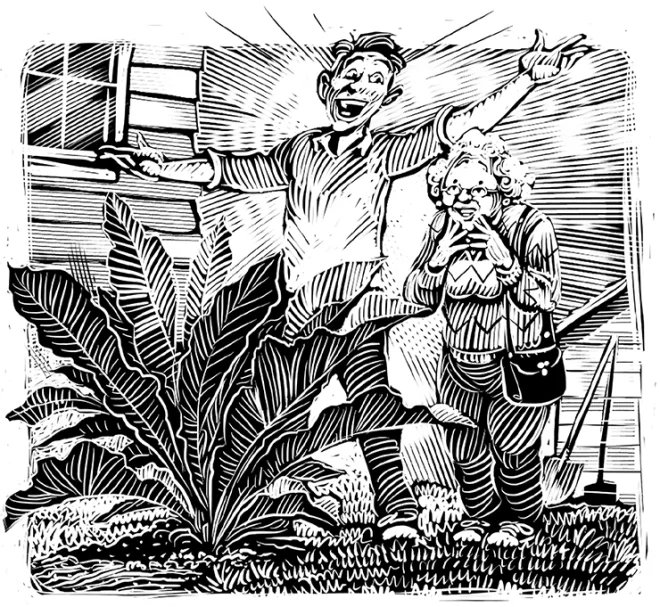To understand my egg-in-the-face horseradish mishap, first you must know about gefilte fish.
Gefilte fish is an ethnic food that originated with Jewish folk of eastern European origin. The primary ingredient is freshwater fish—pike, whitefish, carp—finely chopped by hand and formed into baseball-sized portions, slowly cooked in a broth made from the heads, bones, and skin of the fish. In this country, it is primarily served as a first course at Spring and Autumn holidays such as Passover and New Year’s.
The preparation is long and labor-intensive, involving hours of chopping by hand. Though in more recent decades gefilte fish has become available already prepared and sold in jars, some holdouts, like my mom, always insisted on preparing it at home, certain—and correctly so—that the storebought product was quite inferior. Her gefilte fish, a source of justifiable pride and served at holiday dinners with extended family, was legendary. It always elicited warm praise from the assembled.
Gefilte fish is served with grated horseradish. While commercial products have long been acceptable, my mom insisted on serving horseradish that she had grated by hand, choosing a large and firm horseradish for that purpose at the grocery store.
So there we were, my wife and I, in our first home in a country setting. It was the perfect opportunity, I thought, to surprise my mom with a fresh, homegrown horseradish in time for the Autumn holiday. How proud she would be, I was certain, to serve her renowned gefilte fish—with horseradish grown by her precious son!

I had learned through sweat-filled experience that the location of our first vegetable garden was far too rocky for a root vegetable. [Editor’s Note: Harvey’s hilarious “Broken Trowel” about this ran in our Summer Issue.] I chose a small and special spot behind our house, one that offered rich soil and received full sun. I dug a deep hole—at least 18 inches down—loosened the soil, added some compost and fertilizer, and planted a horseradish root I’d been lucky to find at a rural garden center.
Green shoots soon appeared and grew into leaves. I checked my horseradish plant almost daily, carefully weeding around it, watering by hand, and adding liquid fertilizer to both the ground and leaves. I handpicked off the few bugs that appeared, even if they appeared to be transient visitors on their way elsewhere. As Summer progressed, the plant grew bigger and bigger and filled out with large leaves that were vibrant in color. I imagined the monster horseradish root that lay underneath this prolific display of plant vigor. I could hardly wait until harvest time.
That Autumn my folks drove up for a visit. It was a beautiful late September day, the trees beginning their seasonal display, the sky a bright blue, the air crisp but not cold. I took my mom out into the backyard, spading fork in hand, explained I had a surprise for her, and led her to my plant, sitting majestically alone in the rear of the yard.
“I grew you a horseradish!” I crowed.
She was excited and exclaimed about how large the plant was. Holding the leaves aside, I began to carefully dig up my offering, making a wide hole for my anticipated enormous root. I dug. And I dug. And I dug. I finally pulled up the root of the prolifically leafed plant I had nurtured all summer long.
It was a skinny little root only a couple of inches long. Behind me I heard a chuckle. Then a stifled laugh. Then hysterical laughter, the sort that overwhelms the laughing party to the point of breathlessness. My mom, who in good Jewish mother fashion had always celebrated my most modest accomplishments as if I were a Nobel Laureate, had completely lost control and, for the first time in my life, laughed at my efforts. Actually, she roared.
I couldn’t help but join in.
“So, maybe next year you’ll grow a bigger one,” she said when she finally regained control.
A few years later, after moving to a small city with a large yard, I planted another horseradish, nurtured it for a while, and then left it alone. I waited a couple of years while the plant sent out underground shoots and spread over a larger and larger area of my garden. Finally I mustered the courage one day to—quietly and alone—dig up what thankfully were some large horseradish roots. A few days later, I presented them to my mom. The horseradish curse was lifted.
When she served her gefilte fish that Autumn, she proudly told all that I had grown the horseradish. We smiled at each other, recalling that first try—but saying nothing. ❖


 Previous
Previous


Hello Harvey~Thx~ for sharing. I’m just planting for the first time some Horseradish. I can’t wait ????